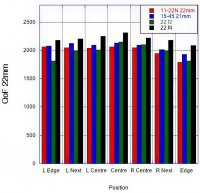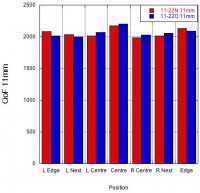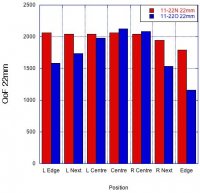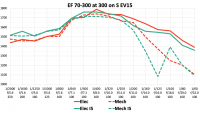TL;DR
A couple of highlights:
Will be interesting to do something similar when I start my R collection. Might I expect similar results?
Details
This is primarily a shutter shock comparison. I wasn't trying to achieve optimal performance for each lens, just compare the difference between electronic and mechanical shutter settings, all other things being equal. In some cases I compared with different tripods or image stabilization using the same basic setup.
FoCal data
The EF-M 32 is a great lens for the M that rival EF L series lenses (see below).
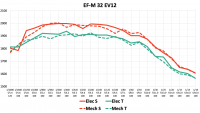
The EF-M 11-22 zoom is another great lens. It does show shutter shock at the tele end.
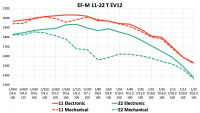
The EF-M 22 is disappointing with wide apertures. It gets much better at f/4. This may be copy variation as Alan F points out.
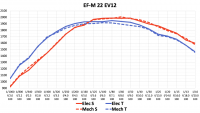
The EF 85 1.4 L IS has the most consistent performance of any lens I tested.
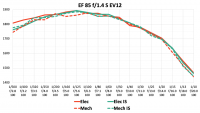
The EF 135 f/2L has outstanding performance, even on an M6. The EF 200 f/2.8L might be worth a look.
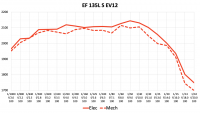
The EF-M 28 Macro IS needs f/4 and a solid tripod.
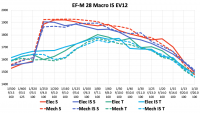
Possibly the best of the mid-range EF-M zooms, unless you need the additional reach. Some shutter shock at the tele end.
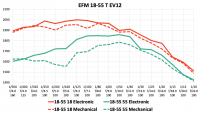
The EF-M 15-45 is poor at the tele end and suffers from shutter shock.
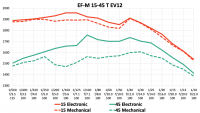
The EF-M 18-150 is poor at the tele end and suffers some serious shutter shock.
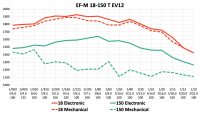
The EF-M 55-200 is poor at the tele end and can suffer significant shutter shock. Thought the performance isn't that much worse than the 18-150 at 150. The Systematic tripod reduced the shutter shock.
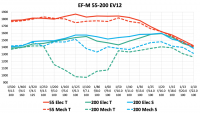
I sometimes use a 70-300L or 100-400L on the M, but didn't have enough room to test them appropriately. Some preliminary data showed much better tele performance and significant shutter shock as might be expected, both with and without IS.
A couple of highlights:
- I'm pleased with the overall performance of the M6 mark II. I now have a much better idea what to expect from my gear.
- Shutter shock primarily affects the tele end of the zooms, sometimes drammatically. Electronic shutter preferred when possible.
- A stable tripod helps. Series 3 Gitzo performed much better than Series 1 Gitzo in most comparisons.
- EF-M 32 and EF-M 11-22 are great lenses, comparable to my EF L series lenses. They were already my favorite EF-M lenses.
Will be interesting to do something similar when I start my R collection. Might I expect similar results?
Details
This is primarily a shutter shock comparison. I wasn't trying to achieve optimal performance for each lens, just compare the difference between electronic and mechanical shutter settings, all other things being equal. In some cases I compared with different tripods or image stabilization using the same basic setup.
- Lot's of M experience (M, M3, M5, M6 mark II) and a full set of EF-M lenses. Meets my needs for everyday carry. Use a 1DX mark II and EF L series when I want to get more serious. Sometimes use EF lenses like the EF 85L and EF 135L in special situations since there is no equivalent, otherwise I stick to the M lenses for size and weight.
- Shoot mostly handheld. When I need a tripod I typically use a Gitzo 1542T Traveler tripod with the M series, but also have a Gitzo 3532LS Systematic for the serious stuff.
- Long time FoCal user, starting with 1.8 several years ago. Used FoCal 3 with the 150mm and 210mm targets from Reikan. Used large target for wide angle, small target on the teles due to limited space indoors for testing.
- Used a 12EV lighting setup for the targets to achieve mostly ISO 100 across the shutter range.
- Controlled the camera wirelessly from my phone.
FoCal data
The EF-M 32 is a great lens for the M that rival EF L series lenses (see below).

The EF-M 11-22 zoom is another great lens. It does show shutter shock at the tele end.

The EF-M 22 is disappointing with wide apertures. It gets much better at f/4. This may be copy variation as Alan F points out.

The EF 85 1.4 L IS has the most consistent performance of any lens I tested.

The EF 135 f/2L has outstanding performance, even on an M6. The EF 200 f/2.8L might be worth a look.

The EF-M 28 Macro IS needs f/4 and a solid tripod.

Possibly the best of the mid-range EF-M zooms, unless you need the additional reach. Some shutter shock at the tele end.

The EF-M 15-45 is poor at the tele end and suffers from shutter shock.

The EF-M 18-150 is poor at the tele end and suffers some serious shutter shock.

The EF-M 55-200 is poor at the tele end and can suffer significant shutter shock. Thought the performance isn't that much worse than the 18-150 at 150. The Systematic tripod reduced the shutter shock.

I sometimes use a 70-300L or 100-400L on the M, but didn't have enough room to test them appropriately. Some preliminary data showed much better tele performance and significant shutter shock as might be expected, both with and without IS.
Last edited:

